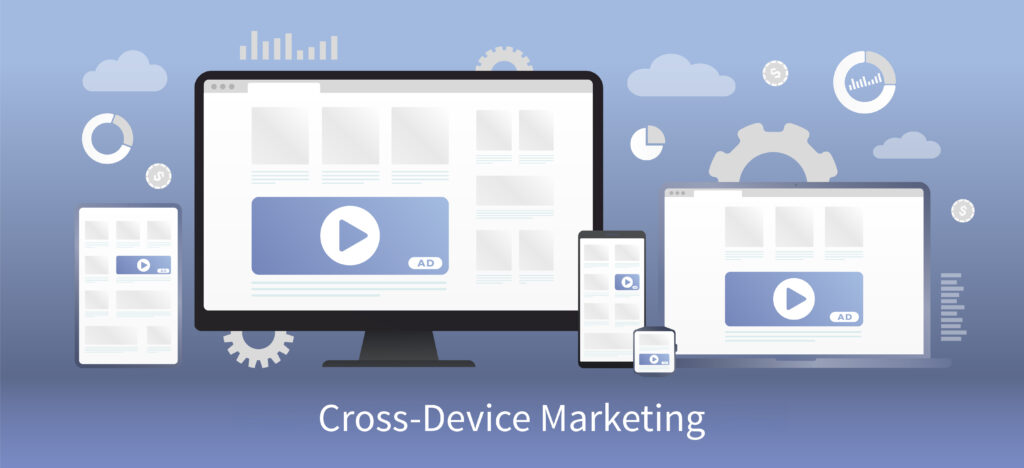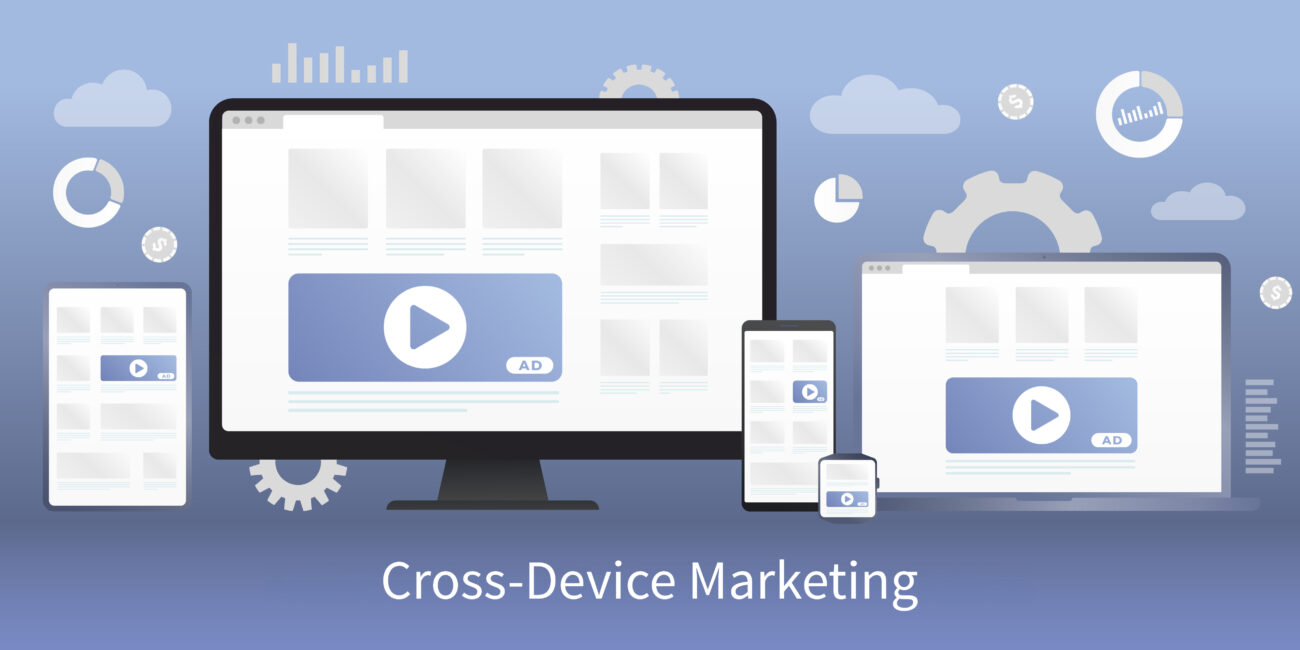Cross-device marketing refers to the practice of delivering consistent marketing messages and experiences across multiple devices that consumers use to interact with brands. This includes smartphones, tablets, desktop computers, laptops, smart TVs, and other internet-enabled devices.
Aiming to reach consumers seamlessly as they switch between devices throughout their daily activities, cross-device marketing ensures a cohesive brand experience regardless of the device used. This approach recognizes the prevalence of multi-device usage among consumers and aims to deliver targeted and relevant marketing content across all touchpoints.
This guide will look into the cross-device marketing strategy and suggest a starting point for those interested in launching a campaign.

What Is Cross-Device Marketing?
Cross-device marketing is a strategy that aims to provide enjoyable experiences to prospective customers as they swap devices while maintaining the brand message. It is considered both very effective and challenging to accomplish. When done proficiently, the consumer will feel fond of your brand, regardless of the device in use. Such positive emotions may lead to immediate and possible subsequent purchases.
Example Cross-Device Customer Experience
Let’s say that our imaginary customer is a man named Albert:
Albert is sitting at home on his couch, watching a streaming show on his smart TV. A streaming ad interrupts his show and advertises a pair of hiking boots he always wanted. Albert excitedly looks up the product review on his laptop and finds it has a five-star rating. He then powers up his smartphone and purchases the boots using the Google Shopping app. As he completes the order, he signs up for the company’s SMS service, which promises to deliver weekly coupons and news.
This situation could be commonplace, but it’s better to do individual research to provide the best customer experience possible for each segment.
Types of User Devices
As technology advances, people continue adding more smart devices to their collections. What started with personal computers (PCs) now includes smart devices within connected smart homes. Here are typical devices that people may possess:
- PCs and laptops
- Smartphones and tablets
- Smart TVs
- Smart speakers
Of these devices, digital advertisements can manifest in such ways as:
- Website ads
- Search engine ads
- Email newsletters
- Streaming ads
- In-podcast ads
- Smart speaker ads
- Mobile website ads
- Mobile in-app ads
Although you don’t need to advertise on every platform, it is imperative to know about and how to use each one so you have the option to do so should the need arise.
Pros of Cross-Device Marketing
As you may guess from the method, cross-device marketing uses each device to reach the customer as often and with as much meaningfulness as possible. Here are some advantages:
Increased Engagement
With cross-device marketing, you take a proactive approach and get in front of the customer instead of waiting for them to come to you. Additionally, you customize each touchpoint to make it easier for them to interact with your brand. As the prospect spends more time with your brand, that experience can eventually become loyal, where the customer returns regularly.
Multi-Channel Optimization
Since each marketing channel is different, an approach on one channel may not work as well on another. Cross-device marketing considers the type of channel and target consumer and meshes them together for complete cohesion. Even with adding more channels, this method optimizes everyone for the best possible experience.
Precise, Relevant Data
Cross-device marketing uses advanced customer data platforms (CDPs), such as Salesforce or SAP, that collect data from many touchpoints. Marketers can exploit the information with incoming data to ensure customer satisfaction. Such data can be further compared with similar segments to produce a broader perspective that benefits the entire company.
Cons of Cross-Device Marketing
Although cross-device marketing has its perks, it also has drawbacks. Here are some cons to be aware of:
Possible Annoyance to Customers
When a prospect sees your brand each time they swap devices, they may feel a twinge of resentment. It can be easy to overdo it, especially if your company has a surplus of funds for the occasion. In this case, pay attention to the level of interactions you get and adjust your strategies accordingly.
Timing Issues
Even with all of the data available, you may not always be able to reach your prospect at the perfect time. This can be frustrating because you don’t know what to change at the exact moment to encourage results. Remember that some things are out of your control, and some days, consumers may just have powered off their devices or gone on a vacation. In that case, plan for their return with fresh advertorials.
Incorrect Channels
New apps, websites, and streaming services appear daily, making selecting the right channels even more difficult. Additionally, prospects may stop using some channels altogether, leaving you with an empty node for data. Apps rise and fall in popularity constantly, so it is up to you to keep up with the trends to stay relevant.

How to Start a Cross-Device Marketing Campaign
Cross-device marketing is more complex than other methods but worth the effort. Follow these steps to begin your own cross-device marketing campaign:
Analyze the Audience
In cross-device marketing, it is rather crucial to develop a buyer persona from the very beginning. This single tool can dramatically boost your results while saving you from massive headaches. A customer avatar can help you regain your bearings when you feel lost and help you focus on putting the consumer first. Once you generate a suitable persona, continue to alter it when you discover new information — the goal here is to be practical, not perfect.
In particular, decide which devices and services they will most likely use, as this will save you a lot of trouble later.
Develop an Initial Strategy
As in our above example, Albert is most likely sitting at home in front of his smart TV with his smartphone and laptop nearby. Judging from this situation, we could begin our process with in-stream advertisements. From there, we could expand further to be in his presence as much as possible on all of his devices when he is not at his job. All the while, we will tailor each advertisement to meet his needs.
Design a cross-device marketing plan based on your customer persona to the best of your ability. Then, input any available data into your CDP and analyze it. You will be surprised at what you can find and may be able to help the customer even more so than you initially thought possible.
Dig Into Segments
After running your campaigns for a few weeks, you should have enough data compiled to make educated conclusions. From here, identify trends pertaining to successes and failures that you can work on to improve results. The goal here would be to develop a solid picture of the situation to ultimately increase conversion rates. Additionally, you may want to abandon channels that aren’t working.
Best Practices for Cross-Device Marketing
Revolve Your Decisions Around Data
Working on a cross-device marketing account can be exciting, but don’t jump in front of the horse here. Always wait for the data first, analyze it, and then decide your next move.
Optimize Campaigns for the Best KPIs
Regardless of the channel, always look to improve KPIs to the best of your ability. This will steer your marketing ship in the right direction and remove many ambiguities. Also, ensure you focus on the most relevant KPIs for the specific channel.
Omnichannel Approach
The omnichannel approach gears your cross-device campaign toward appearing consistently across all advertising channels. This allows you to get your brand in front of a particular prospect with the same (or similar) ads, which get you to spend time with the customer and can create a bond. Developing a bond can lead to loyalty, purchase opportunities, and repeat sales.
How to Ensure You Have a Unified Approach
A unified approach is essential for building brand awareness, particularly in the early stages of your startup. A solo marketer must follow the copy, messaging, and graphic theme. A team of marketers, however, should appoint a designated project leader who can oversee all campaign activities.
Now, It’s Your Turn to Start Cross-Device Marketing
At J&L Marketing, our trained staff has extensive experience with cross-device marketing and is ready to answer any questions you may have about the method. We can even design complete cross-device campaigns and run them on your behalf! Reach out to us today to see all your options.



